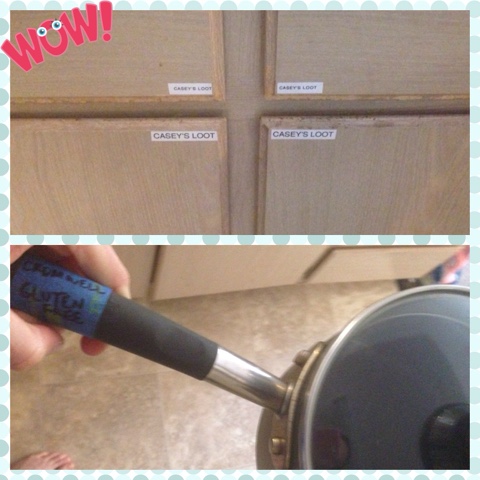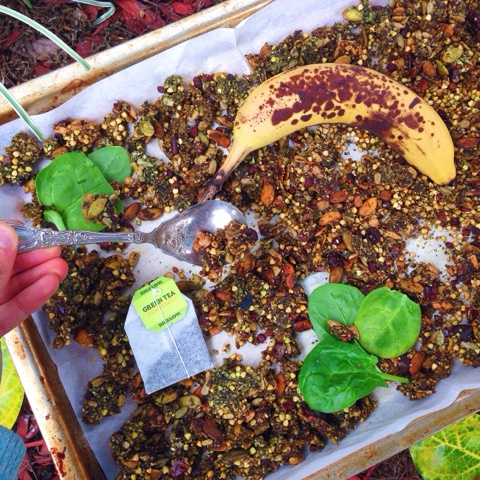The First Six Steps You Need to Take After a Celiac Diagnosis
My three-year celiac disease anniversary snuck up on me as quickly as the disease itself. Likely because it was the middle of finals week, I actually didn't even notice my celiac anniversary on May 3. In fact, I have a throwback post from Facebook to thank for remembering the date at all!
1. Meet with a nutritionist recommended by your doctor.
A nutritionist can also help warn you about any deficiencies commonly found in those who follow a gluten-free diet and recommend supplements. Perhaps the best part? When you walk out your meeting, you won't just know what "gluten-free" means. You'll also know that surviving - and thriving - on a gluten free diet is totally possible!
I can't emphasize enough how helpful blogs can be - and not just because I now write one. On blogs, I learned some of the common mistakes new celiacs make, tricks for saving money on gluten free groceries and ways to cope with a new diagnosis. I was instantly addicted to Gluten Dude and Celiac And the Beast for their informative content and their honest reflections on how confusing, frustrating and empowering celiac can be.
At the same time, you should also clear out a separate set of cabinets or drawers that will only contain gluten free food. This prevents cross contamination - and keeps people who don't need to follow a special diet away from your gluten free goodies! You should also consider buying separate cooking instruments, pots and pans and a dish sponge. Many pots and pans are fine to be used with gluten and gluten free foods, as long as they are washed well. However, you'll want to get a separate toaster, separate non-stick pans (if they have lots of scratches where gluten can hide), cutting boards and wooden spoons.
Basically, any item scratched up or porous enough to trap gluten should probably be replaced. To make life easier, try to buy GF items in a separate color than other pans or label them "gluten free only."
B) Research grocery stores that offer plenty of gluten-free options. My favorite grocery store of all time is Sprouts - it's cheap, it sells tons of gluten free items and most GF items are obviously labeled. Other places I shop include Vons, Barons Market and, sparingly, at Whole Foods Market (which has tons of options but is super pricey).
6. Meet again with your doctor - or schedule a future checkup.
In the three years I've struggled, adapted to and embraced celiac disease, I've learned a lot. Not only have I discovered the fragility and perseverance of the human body, but I also found out a lot about myself. Really, though, I have the support of dozens of friends, family, and medical professionals to thank for my health today.
Instead of making a cake, for this year's anniversary, I want to offer some food for thought. In particular, the six steps everyone should initially follow after a celiac diagnosis.
1. Meet with a nutritionist recommended by your doctor.
As difficult as my celiac journey ended up being, I feel blessed to have been diagnosed relatively quickly, been treated by a skilled gastroenterologist, and to have consulted with a nutritionist the same day I met with my doctor about my endoscopy results. You should meet with a nutritionist for several reasons.
First, obviously, you need to learn what this whole "gluten free" diet thing actually means! Unfortunately, avoiding gluten can be harder than it sounds - I've even found plates made with wheat instead of paper! - but a nutritionist can warn you of the common places gluten hides. If your experience is anything like mine, your nutritionist might also give you a pamphlet with common terms for gluten and lists of gluten-free foods. While you can find similar info online (I recommend this amazing gluten-free list by Beyond Celiac), having a reference sheet makes your first grocery trip a molehill instead of a mountain!
A nutritionist can also help warn you about any deficiencies commonly found in those who follow a gluten-free diet and recommend supplements. Perhaps the best part? When you walk out your meeting, you won't just know what "gluten-free" means. You'll also know that surviving - and thriving - on a gluten free diet is totally possible!
2. Research like it's your job! (Newsflash - it kind of is!)
When I first heard my doctor say, "gluten," I had no idea what she meant. A bird? A plane? A molecule? Though not completely credible, Google answered most of my basic questions - and reassured me that there were plenty other young celiacs in the world! Besides learning about your disease, researching your diet also helps. As an overachiever, I used the Internet, checked out books at the library (from Living Gluten Free for Dummies to medical books on celiac to cookbooks) and immediately started reading blogs.
 |
| Gluten Dude also shared the story of my hospitalization...and triggered hundreds of kind comments from readers all around the world! |
I can't emphasize enough how helpful blogs can be - and not just because I now write one. On blogs, I learned some of the common mistakes new celiacs make, tricks for saving money on gluten free groceries and ways to cope with a new diagnosis. I was instantly addicted to Gluten Dude and Celiac And the Beast for their informative content and their honest reflections on how confusing, frustrating and empowering celiac can be.
For a new celiac, I particularly recommend participating in forums on Celiac.com (for advice and support) and reading the blogs I mentioned above as well those listed under my "Favorite Blogs" tab. Don't be afraid to reach out to other celiac bloggers either. In my experience, we really are all in this together and most celiacs want to help others however they can!
3. Spread the news to family and friends.
There's nothing worse (besides being glutened!) than being offered gluten-filled food shortly after diagnosis. Not only is it awkward to decline, but it's also a reminder of the favorite foods you can't enjoy anymore. To help prevent this from happening, keep friends and family in the loop about your diagnosis. Give them the basics of celiac disease, what you can and can't eat, and that even a little gluten will make you sick.
Some people may adjust to the news easier than others. For instance, my family immediately worked to de-gluten our kitchen and learn how to cook me safe food, but some of my friends took longer to realize I couldn't eat like I used to. My biggest piece of advice? If someone has a problem with your celiac disease - such as refusing to accommodate your dietary needs or making fun of your new diet - don't let your friendship threaten your health.
Gluten free cake > narrow-minded people everyday!
4. Clean out the cabinets!
You've probably heard the saying, "Out of sight, out of mind." In the case of celiac disease, it changes to "out of the house, out of mouth." If you live alone or the rest of your family is going gluten free, you can donate or throw out all of your gluten-containing food. What foods are those? Some "gluten" buzz words include wheat, rye, barley, triticale, malt, brewer's yeast and wheat starch. I'd also suggest checking the ingredients against this list of "sources of gluten" if you're unsure.
If you're the only one in your house going gluten free, just throw out the foods only you used to eat.
If you're the only one in your house going gluten free, just throw out the foods only you used to eat.
At the same time, you should also clear out a separate set of cabinets or drawers that will only contain gluten free food. This prevents cross contamination - and keeps people who don't need to follow a special diet away from your gluten free goodies! You should also consider buying separate cooking instruments, pots and pans and a dish sponge. Many pots and pans are fine to be used with gluten and gluten free foods, as long as they are washed well. However, you'll want to get a separate toaster, separate non-stick pans (if they have lots of scratches where gluten can hide), cutting boards and wooden spoons.
Basically, any item scratched up or porous enough to trap gluten should probably be replaced. To make life easier, try to buy GF items in a separate color than other pans or label them "gluten free only."
5. Shop 'till you drop.
I'll admit - the first time I shopped gluten free at the grocery store, it was a struggle! If you're not used to reading labels or searching for allergen-friendly brands, shopping will take much longer than usual. To make your first trips easier, I have a few tips:
A) Stick to naturally gluten-free foods like fruits, vegetables, dairy (if you can tolerate it - many celiacs can't), and meats. Many grains are also naturally gluten free, but could be processed with gluten and therefore need to be checked before purchasing. (Look out for a "processed on shared equipment with wheat" indication on the nutrition label. If you see a "certified gluten-free" symbol instead, you're good to go!)
B) Research grocery stores that offer plenty of gluten-free options. My favorite grocery store of all time is Sprouts - it's cheap, it sells tons of gluten free items and most GF items are obviously labeled. Other places I shop include Vons, Barons Market and, sparingly, at Whole Foods Market (which has tons of options but is super pricey).
C) Order food online. If you live somewhere with limited gluten-free options, sites like Amazon Prime are lifesavers. I love Amazon Prime because I can buy most of my favorite products, shop in bulk and receive my orders quickly. My other favorite food site is Nuts.com where I buy all of the cross-contamination-free nuts, seeds, grains and goodies I use in my homemade granola!
6. Meet again with your doctor - or schedule a future checkup.
If your doctor doesn't immediately request a follow-up appointment after your diagnosis, set up one yourself. Celiac disease can seem straightforward: stop eating gluten and boom, you're healthy again! In my case, healing didn't follow a linear timeline. I needed to experiment with a liquid diet, undergo a hospitalization, use a feeding tube and be closely monitored - in my blood work, vitamin levels and bone density - for almost a year until my body started recovering from gluten damage.
Some celiacs start feeling better right away; for others, it takes a lot of time. Instead of walking out of your doctor's appointment feeling like you found your "cure," prepare for the unexpected. Doctors, fellow celiacs and bloggers like me are here to help new celiacs adjust, learn and, eventually, thrive. Don't forget to take advantage of those resources!
In the three years I've struggled, adapted to and embraced celiac disease, I've learned a lot. Not only have I discovered the fragility and perseverance of the human body, but I also found out a lot about myself. Really, though, I have the support of dozens of friends, family, and medical professionals to thank for my health today.
My biggest hope? By my next celiac anniversary, I can say I helped someone else as much others helped me.
Related Articles You May Enjoy:
- Favorite Gluten Free Companies Every Celiac Should Know
- Four Tips on Surviving Being Glutened
- Gluten Free Packaged Foods Always in This Celiac's Pantry
- 7 Gluten Free Frozen Foods Always Found in a Celiac's Freezer
Do you celebrate your celiac anniversary? Any other tips you would tell a newly diagnosed celiac? Comment below!









PLATES with gluten?!?!? Ok that's terrifying. I have a really severe peanut allergy that I need to deal with, but I feel like that generally applies to foods only. Gluten seems to sneak into a lot of things like makeup and beauty products, which can be scary when you aren't aware of it.
ReplyDeleteHaha right?!? I was like, "Well, I'm not buying any plates today...."
DeleteGreat blog... Here I found very important steps, helpful for all celiac disease patients. I really appreciate your blog. Thanks for sharing
ReplyDelete